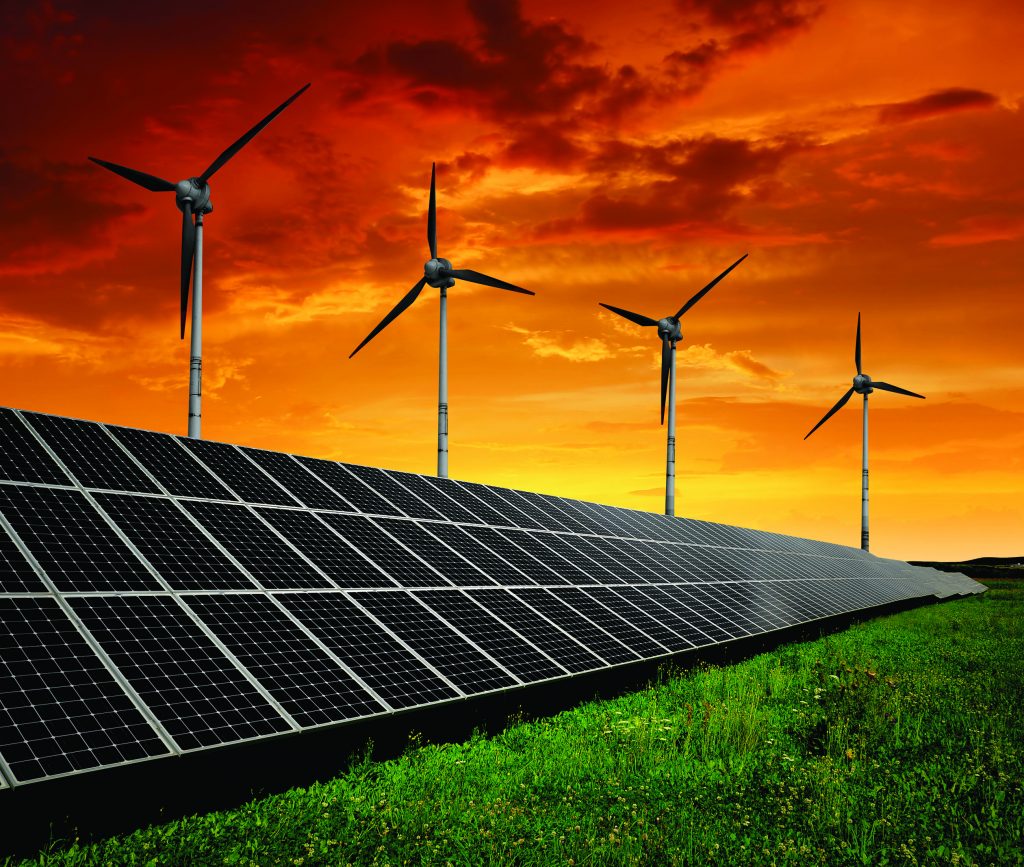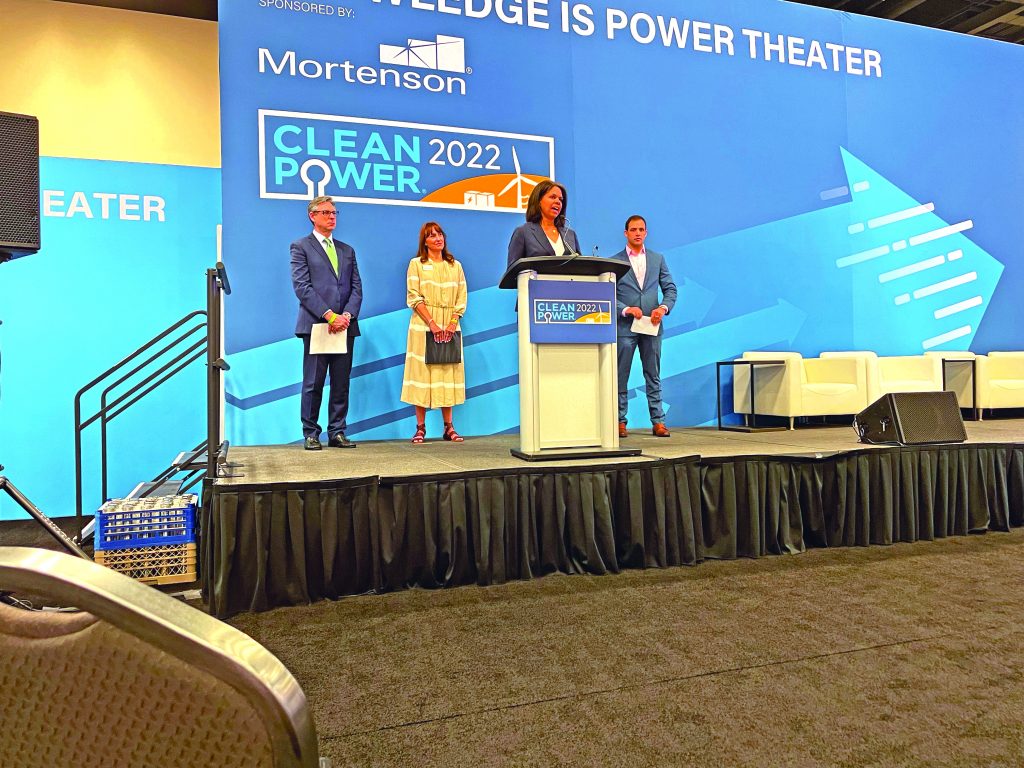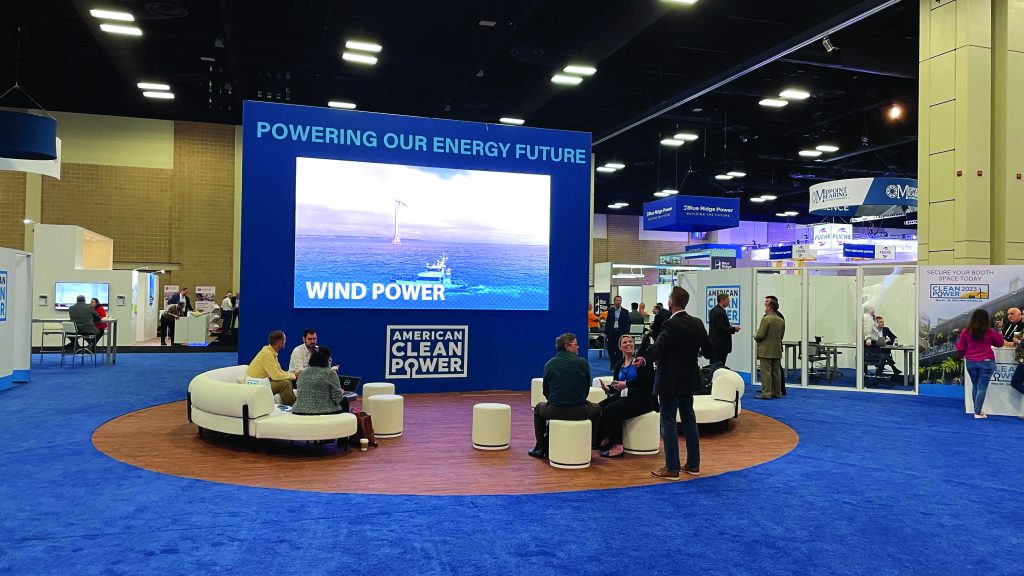Looking at the growth record of wind energy and other renewables in the U.S. is an ideal way to see how far clean-energy alternatives have come.
The first wind turbines in the U.S. went in the ground more than 30 years ago in the 1980s, but it took until 2002 before 1 GW of operating wind and solar were on the grid.
There was gradual growth from that point, and the country would hit 100 GW in the next 14 years. But, in the latter part of the 2010s, the industry kicked into overdrive, and in five years, that number doubled to 200 GW.
To celebrate that 200-GW milestone, executives from renewable energy companies and the American Clean Power Association took time to discuss that achievement, as well as what future challenges the industry faces, during a press conference at CLEANPOWER 2022 in San Antonio, Texas, May 17.
“Low costs and demand have really been critical factors in that growth of this industry,” said John Hensley, the American Clean Power Association’s vice president of research and analytics. “Clean power is the top choice of new power capacity on the grid today; 81 percent of all new power plants added in 2021 were in the form of wind, solar, and battery-storage facilities. And that’s not a new trend. For the past five years, renewables and battery storage represent 63 percent of all new additions to our electric system.”

More growth expected
That growth isn’t expected to stop as more than 90 percent of all projects in the interconnection queues — which is a good indicator of power plants being added to the grid — are in the form of wind, solar, and battery storage, according to Hensley.
“Now, clean power has become an integral part of the electricity system; today, over 13 percent of your electricity comes from wind and solar plants across the country,” he said. “In certain states, that percentage is even higher. States like Iowa, South Dakota, Oklahoma, and Kansas all generate more than 40 percent of their electricity from wind and solar projects. And Iowa leads the way at 56 percent of their generation mix coming from solar and wind.”
As much progress as the renewable energy industry has made over the last few years, a lot more will be needed if the U.S. is going to reach certain energy goals, according to Heather Zichal, CEO of the American Clean Power Association.
“Don’t get me wrong, 2021 marked a record year for clean power,” she said. “(But) we need to increase our project volume by 65 percent over 2021 to reach a net-zero grid by 2035. The headwinds our industry faces this year indicate that we may not be able to even maintain the momentum of the last two years in 2022. While installations and storage are similar to last year, supply chain woes, trade barriers, bottlenecks, and transmission and policy uncertainty all threaten future development.”
Transitioning need
Hensley said this is a critical juncture for renewables.
“We need to be transitioning,” he said. “We need to be deploying more and more renewables every year. That’s what’s needed in order to enable the clean-energy transition that will help to push this country toward a net-zero emissions grid by 2035.”
The good news is that many renewable companies are leading the way to help make that 2035 net-zero goal a reality.

BHE Renewables, which is part of Berkshire Hathaway Energy, has invested more than $35 billion in wind, solar, and geothermal projects that the company owns, and it has also provided about $7 billion in financing for other wind-energy projects, according to BHE Renewables president and CEO Alicia Knapp.
“According to the 2021 Clean Power Annual Report that was just released, our investor-owned utilities have the most operating clean power,” she said. “Berkshire Hathaway Energy also has the second largest operating renewable fleet and is the top purchaser of renewable energy. We’re very proud to be leading the way to a sustainable energy future.”
Those BHE investments’ ultimate goal is to achieve zero greenhouse gas emissions, but Knapp said more will be needed.
“Part of that is generating more renewable energy, but to do it, we also have to expand our transmission system, and that’s key,” she said. “It’s not enough to just deliver more clean energy; it has to be reliable and affordable for our customers. So, let’s talk about reliability. This is a key priority for our organization and the industry. As we transition to cleaner energy, we need to be sure our customers can still count on us to meet the needs of their lives and their businesses. It means we have to advance energy storage, and we have to recognize the benefits of clean baseload geothermal energy. We’re constantly innovating and exploring new opportunities in these areas.”
Avangrid Renewables: A leading company
Another renewables company leading the charge is Avangrid Renewables.
“We’re incredibly proud to be a leading company in the effort to realize a sustainable energy future world,” said Jose Antonio Miranda, onshore president and CEO of Avangrid Renewables. “We have the third largest portfolio of clean-energy assets in the country. And today, we operate 8,000 MW of wind and solar across 23 states. One of those states is Texas. It’s our host for this year’s conference and played an important role in the winter storm that caused significant power outages and extraordinary hardship for many residents. Even through that extreme weather, our agile and dedicated operation team safely maximized generation and delivered power to our customers under exceptionally challenging conditions when they needed it most.”
Avangrid is also a leading offshore wind developer in the U.S. as well, according to Miranda, with about 5,000 MW of projects in the portfolio.
“That includes the first-in-the-nation, 800-MW Vineyard Wind project,” he said. “And as we continue to grow our renewable portfolio, both onshore and offshore, we are laser-focused on positively impacting our society by creating new high-quality jobs across the U.S. To that end, we are committed to ACPS energy transition for our platform, which is focused to ensure workers, communities, and those historically left behind benefit from the transition to a clean-energy future. We are holding our commitment to these principles by broadening our recruitment to target workers from disadvantaged communities, founding college scholarships, and targeting critical investments in our offshore business to local communities like Bridgeport, Salem, Somerset, or New Bedford. But our industry also is facing some new challenges, by not only threatening the progress that we make, but also potential jobs for economic growth.”

Facing potential challenges
Miranda pointed out that, with increasing gas supply prices caused by the war in Ukraine, the need for energy independence and affordable energy has never been more important than it is now.
Even though the Biden administration has pushed renewable energy efforts, some policies in the works may end up being counterproductive to meeting that zero net carbon goal that is only 13 years away.
A provision in the Coast Guard Authorization Act could affect U.S. vessel construction needed to advance offshore wind projects.
The original bill contained a maritime crew provision that requires crews on construction vessels to be citizens of the U.S. or the flag state of the ship itself.
That provision could cripple the blossoming U.S. offshore sector, according to Zichal, saying the provision would prevent the U.S. from achieving the administration’s target of deploying 30,000 MW of offshore wind by 2030.
However, the good news is the current language in the bill that could be restrictive to offshore wind has been changed, hopefully for the better, but that still remains to be seen.
Another challenge from the Department of Commerce — the Auxin Solar Tariff Petition — is affecting the solar industry. This petition could affect the import of solar panels from countries that include Cambodia, Malaysia, Thailand, and Vietnam.
“Those tariff rates can go up to 250 percent,” Zichal said. “Just the threat of that out there, and the requirement that an industry would have to carry that risk, has led to a major standstill in the deployment of clean energy. Today, I can point to many decisions where companies are faced with that and are delaying and scrapping solar projects across the country.”
Those delays to renewable projects have sent many states and utilities into making decisions that would keep coal assets generating longer than originally planned, according to Zichal.
“We’re seeing again, thousands and thousands of jobs impacted by the delays or potential scrapping of these solar investments and solar projects,” she said. “And I think the most frustrating piece of all of this is that this is a Department of Commerce decision that is 100 percent discretionary. We’ve got a Biden administration that says a lot of the right things about deploying clean energy, but then when you look at some of the policies, (it looks like) we’re actually going in the wrong direction.”
Federal and state policies
Knapp also pointed out the need to look at how federal and state policies can play a major role in the pricing of projects before and after they are operating.
“We need to work together to properly value clean-energy investments and the values of energy security and reducing emissions,” she said. “As energy providers, we’re all dealing with some of the same challenges. We all rely on the (American Clean Power) Association’s policy efforts to help remove barriers to accelerate clean-energy growth, like working to create a more stable supply chain and working toward more efficient and affordable siting and permitting for new projects.”
Keeping the progress going
Challenges persist, but if they can be solved, then that will only help add to the progress that’s already in motion. For example, in Texas, the state generates 116 TW/hr of electricity from wind and solar projects, according to Hensley.
“That’s roughly equivalent to about 24 percent of the state’s electricity needs, so it’s certainly a big part of the grid … in Texas,” he said. “Now, demand for clean energy also continues to rise.”
That clearly can be seen in how buyers — both utilities and commercial-and-industrial (C&I) customers — set a record in 2021 for new clean-power purchase agreements, according to Hensley, with more than 29 GW of new PPAs — a 28 percent increase from 2020.
“They captured about 54 percent of the market, and top buyers in the C&I space include companies like Amazon, Meta, Verizon, and TotalEnergies,” he said. “On the utility side, top buyers for the year include companies like Clean Power Alliance, American Electric Power, and the Tennessee Valley Authority. Now, besides generating clean electricity and delivering low-cost electricity, clean-power projects also delivered for the economy and the environment.”
Green goals, both economic and environmental
Renewable projects are often a crucial boon to low-income counties where projects pay more than $2.5 billion to local communities that go to schools, local infrastructure, and other critical investment needs, while, on the emission side of things, clean-power projects are responsible for avoiding more than 398 million metric tons of carbon emissions, according to Hensley.
“That’s like taking 86 million cars off the road,” he said. “In addition, those clean-air benefits that we all benefit from as a lack of carbon being in the system and in the air, delivers between $18 (billion) to $47 billion in health benefits to Americans across the country, so there’s a lot to celebrate.”
But, as Knapp emphasized, “we definitely have a lot of work to do.”
Miranda also agreed.
“We are working with our colleagues in the industry to find a productive path forward with Congress that supports our national clean-energy and climate goals and the development of a U.S. offshore wind workforce,” he said. “We’re passionate about this incredible opportunity brought upon us — to build the clean-energy future for America. … We look forward to working together to build on the progress that we have already made.”



























